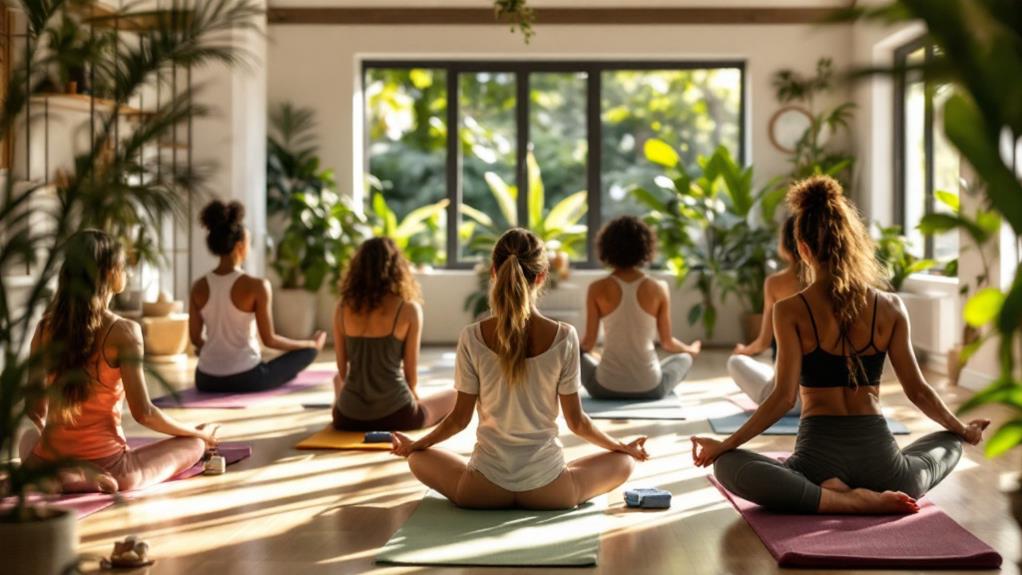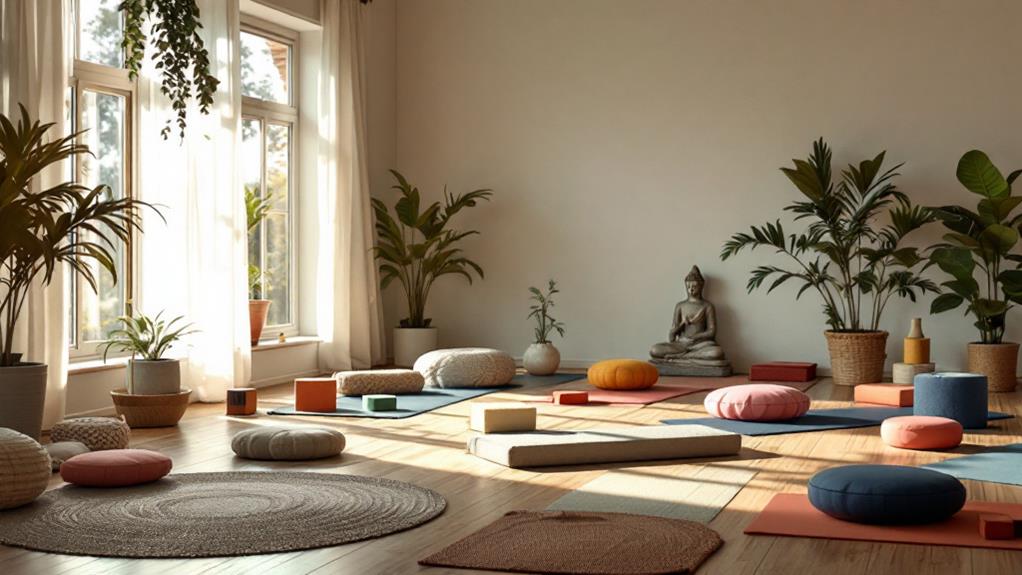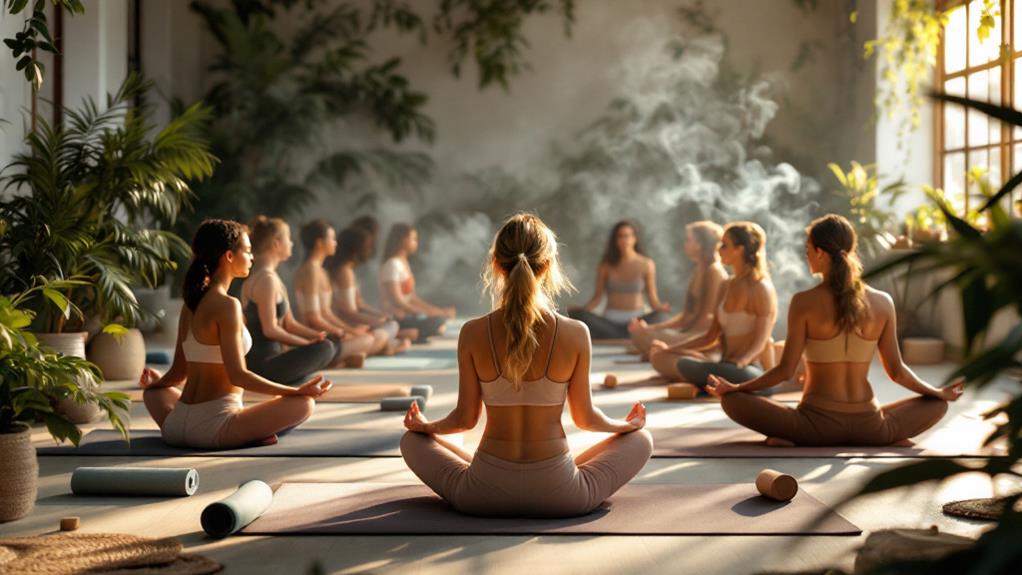How Seniors Can Benefit From Practicing Yoga
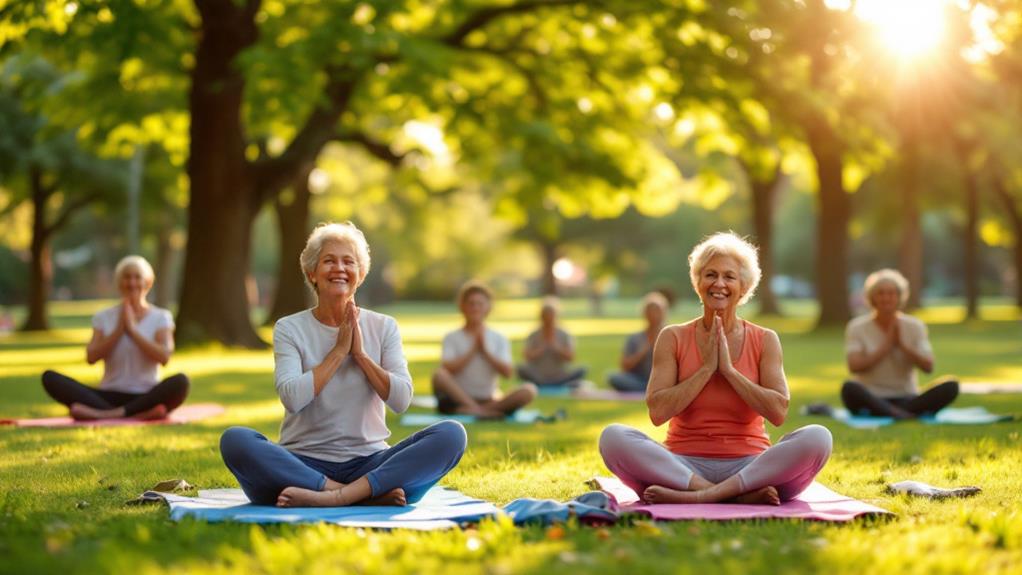
You're never too old to start practicing yoga, which offers numerous benefits for seniors. You'll find that yoga improves your flexibility, balance, and muscle strength, aiding in mobility and reducing fall risks. It supports cardiovascular health by lowering blood pressure and heart rate. Mentally, yoga reduces stress, anxiety, and loneliness while promoting cognitive clarity and emotional resilience. Gentle yoga styles, like Hatha or Chair Yoga, accommodate seniors' needs comfortably. Plus, joining group classes can foster social connections, improving your general quality of life. Welcome the opportunities that yoga provides for a healthier, more connected lifestyle with further insights ahead.
Physical Health Benefits
Yoga offers a multitude of physical health benefits that can greatly improve the well-being of seniors. By engaging in yoga for seniors, you can boost your flexibility and balance, vital factors in reducing the risk of falls. As you grow older, maintaining balance becomes fundamental to prevent injuries, and yoga helps by providing structured movements that improve these skills. Moreover, yoga is a gentle yet effective way to strengthen muscles, promoting better general mobility and supporting independence in your daily activities.
Incorporating yoga into your routine can also have significant cardiovascular health benefits. Regular practice helps lower blood pressure and heart rate, which is particularly beneficial if you're at risk of heart disease. In addition, yoga includes breathing techniques that improve respiratory function. By focusing on deep, mindful breathing, you can increase lung capacity and enhance oxygen intake, contributing to better heart health.
If you experience chronic pain, particularly from conditions like arthritis, yoga can offer much-needed relief. The gentle stretching and strengthening exercises can alleviate stiffness and discomfort, making it easier for you to move with ease. Overall, yoga provides a holistic approach to maintaining your physical health as you grow older.
Mental Well-being Enhancements
While engaging in yoga regularly, seniors can experience notable improvements in mental well-being. Yoga practice offers a holistic approach to improve your mental and emotional health through mindful movement and breathing techniques. Here's how it can make a difference:
- Stress Reduction: Yoga lowers cortisol levels, the stress hormone, providing you with a calmer mind and improved mood. This reduction in stress can help you feel more at ease and balanced.
- Emotional Health: Attending group yoga classes fosters social connections, helping you combat loneliness and isolation. This social interaction is essential for emotional health, providing support and companionship that enrich your life.
- Mindfulness and Cognitive Clarity: By practicing mindfulness in yoga, you can increase self-awareness and cognitive clarity. This can lead to improved focus and memory retention, allowing you to navigate daily challenges more effectively.
- Life Satisfaction: Research suggests that seniors who engage in yoga report higher life satisfaction and emotional resilience. This heightened sense of well-being can improve your general quality of life, making everyday experiences more fulfilling.
Suitable Yoga Styles
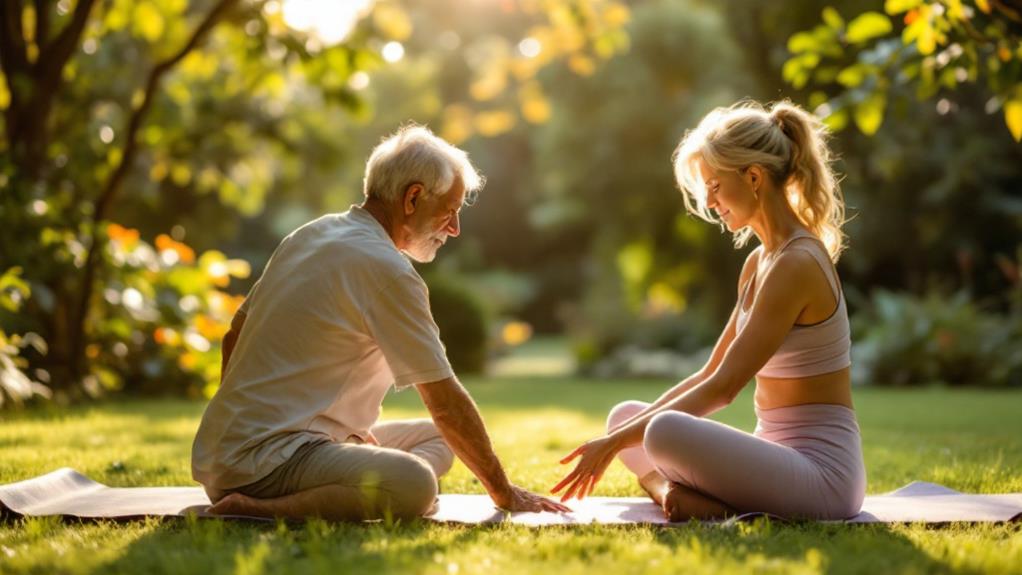
Building on the mental well-being benefits, choosing the right yoga style can greatly improve your practice as a senior. Hatha Yoga offers a gentle introduction to yoga, focusing on basic postures and controlled movements. It's perfect for improving your flexibility and strength without overwhelming you, making it a suitable choice for seniors. If you face physical limitations or balance issues, Chair Yoga provides a practical alternative. By practicing while seated, you can safely engage in yoga, reducing strain and supporting your mobility.
Restorative Yoga is another excellent option, emphasizing relaxation and stress relief. Through its slow-paced, gentle stretches, you can experience deep relaxation and mental well-being. Gentle Yoga, tailored specifically for seniors, accommodates physical limitations and offers a calming experience to elevate your holistic health. It's designed to meet your needs, ensuring you're comfortable throughout your practice.
Lastly, Yin Yoga targets deep connective tissues, improving flexibility with prolonged poses. It's beneficial for seniors at all fitness levels and helps improve joint health and mobility. By exploring these yoga styles, you can find one that aligns with your abilities and goals, enriching your yoga experience.
Starting a Yoga Routine
Before starting a yoga expedition, it's crucial to consult your healthcare provider to evaluate any personal health conditions or physical limitations. This step guarantees you begin your experience safely, with your well-being as the top priority. As a senior, opting for gentle classes like chair yoga or restorative yoga can offer a safe and comfortable introduction. These classes are specifically designed to accommodate varying abilities and provide a supportive environment.
Here's how you can ease into starting a yoga routine:
- Start Small: Begin with short sessions of 10-15 minutes at least twice a week, gradually increasing duration and frequency as your endurance builds.
- Use Props: Incorporate props like yoga blocks and straps to modify yoga poses, making them more accessible and tailored to your needs.
- Seek Guidance: Look for online resources or local classes where instructors have experience working with seniors to guarantee a personalized and tailored approach.
- Listen to Your Body: Always prioritize comfort and safety, adjusting poses when necessary to accommodate your health conditions.
Community and Social Engagement
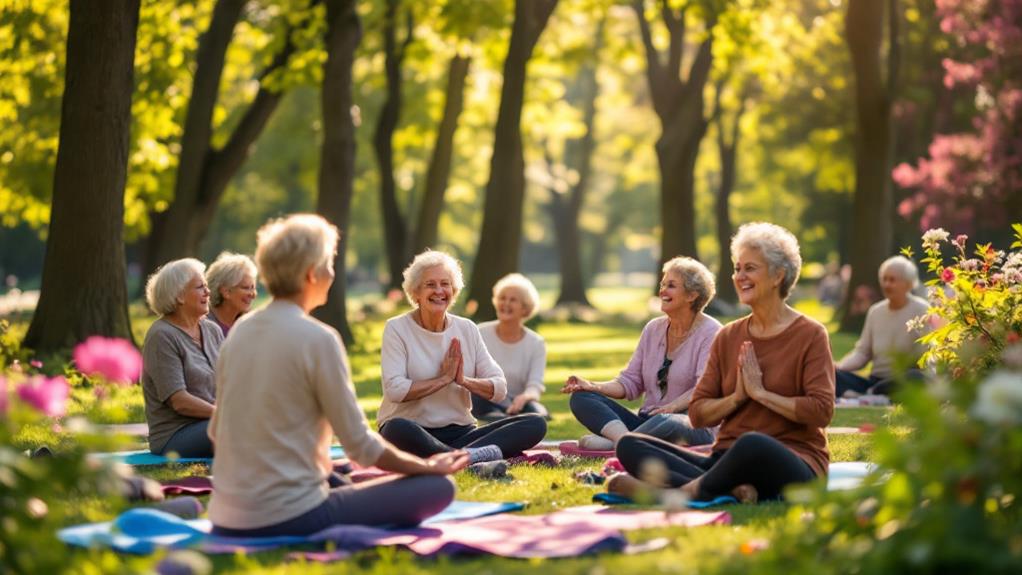
Engaging in yoga classes offers seniors more than just physical benefits; it opens the door to meaningful community and social engagement. By participating in group sessions, you tap into a lively social outlet that fosters community engagement. These classes aren't just about poses and stretches—they're a great way to combat feelings of loneliness and build lasting friendships. With 21% of adults in their sixties and older practicing yoga, you're joining a growing community of like-minded individuals.
Group sessions provide opportunities for social interaction where you can meet peers and enjoy shared experiences. This social aspect is vital, as it improves motivation, accountability, and commitment to regular practice. Many senior living communities have recognized these benefits and now offer yoga programs tailored to residents. These programs not only promote shared wellness goals but also create an environment where you can flourish emotionally.
The regular social interaction in yoga classes can greatly reduce depression, contributing to your complete well-being and quality of life. By embracing the communal aspect of yoga, you're not just improving your health—you're enriching your life with friendships and a supportive community that encourages continuous growth.
Pain Management Techniques
While fostering community through yoga improves your social life, the practice also offers considerable benefits for pain management. Yoga can help alleviate chronic pain by incorporating gentle stretches targeting muscle tension and inflammation. This makes it an effective complementary therapy for conditions like arthritis. To benefit from yoga, you should focus on slow controlled movements, which boost circulation and reduce muscle soreness. This promotes healing in areas affected by chronic pain. Here are four ways yoga can improve your pain management techniques:
- Reduce Medication: A study found that participants practicing yoga needed less pain medication after just four weeks. This shows how yoga can help manage pain levels effectively.
- Improve Body Awareness: Regular yoga practice improves body awareness, allowing you to better manage discomfort and recognize pain triggers.
- Lower Stress Levels: Mindfulness and relaxation techniques in yoga can greatly lower stress levels, which are often linked to increased perception of pain.
- Improve Mobility: By targeting muscle tension and inflammation, yoga can help increase your mobility and reduce those persistent aches and pains.
Sleep Quality Improvement
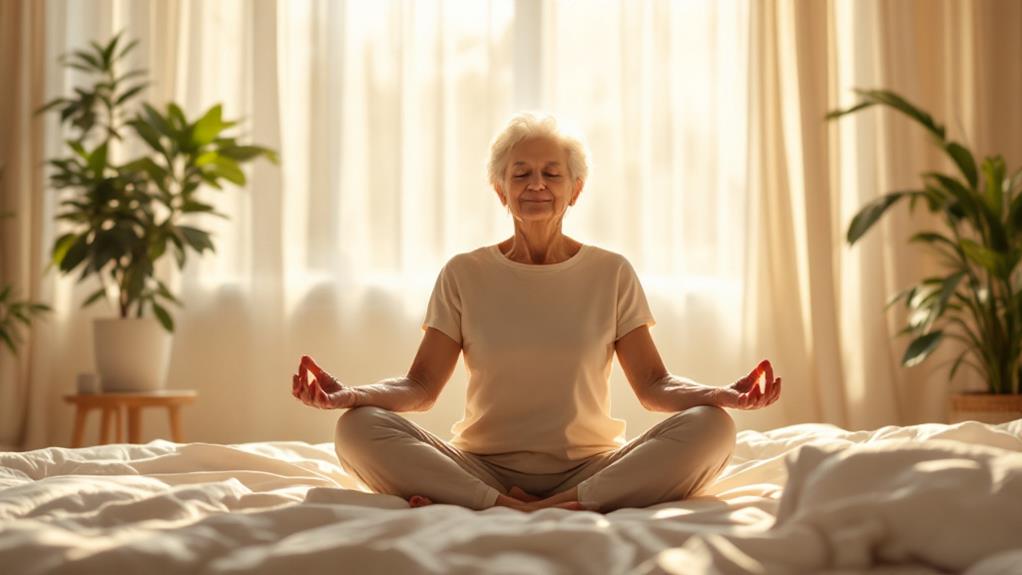
Yoga isn't just about flexibility and balance; it can greatly improve your sleep quality. As a senior, practicing yoga can help you fall asleep faster by reducing sleep latency. This means less time tossing and turning and more time enjoying deep sleep. Yoga's emphasis on relaxation and breathing techniques calms your mind, making it easier to drift off peacefully. If you've been struggling with insomnia, incorporating yoga into your routine could be a game-changer.
Studies have shown that consistent yoga practice over six months markedly improves sleep quality for seniors. You'll not only fall asleep more quickly but also experience longer durations of deep sleep, which is vital for restorative rest. This improvement in sleep quality translates to fewer disturbances during the night, leaving you refreshed and energized the next day.
Moreover, the relaxation you gain from yoga doesn't just stop at bedtime. The breathing techniques and calming exercises you learn can promote comprehensive wellness, helping you feel more centered throughout the day. By practicing yoga, you're not just addressing sleep issues; you're improving your overall quality of life, allowing you to enjoy each day to its fullest.
Cardiovascular Health and Stress Relief
Beyond improving sleep quality, yoga also plays a vital role in boosting cardiovascular health and relieving stress for seniors. Engaging in regular yoga sessions can lower your heart rate and improve general cardiovascular health, reducing your risk of coronary heart disease. Studies show that yoga helps decrease blood pressure more effectively than other relaxation methods, like simply listening to music.
Furthermore, the calming environment of a yoga class fosters relaxation and mitigates stress responses, essential for maintaining heart health as you grow older. By incorporating slow breathing techniques, yoga greatly relieves anxiety, promoting both mental and physical peace and well-being. A consistent yoga routine improves your stress management skills, leading to better coping mechanisms and potentially decreasing the need for stress-related medications.
Consider these benefits:
- Lower Heart Rate: Regular practice can help maintain a healthy heart rate, vital for cardiovascular health.
- Reduced Blood Pressure: Yoga is more effective than many other methods in lowering high blood pressure.
- Stress Relief: It promotes relaxation, mitigating stress responses that impact heart health.
- Anxiety Reduction: Slow breathing techniques in yoga relieve anxiety, boosting emotional well-being.
Embrace yoga to support your cardiovascular health and enjoy lasting stress relief.

